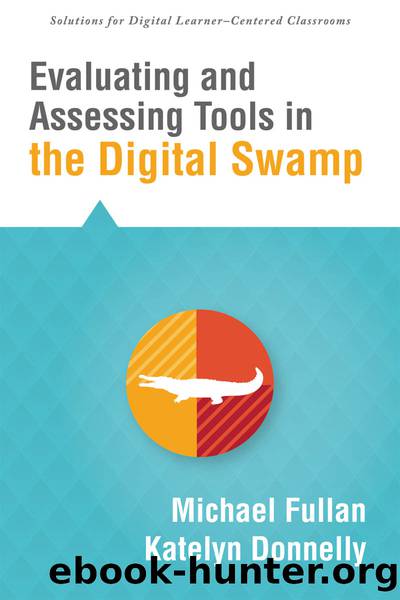Evaluating and Assessing Tools in the Digital Swamp by Fullan Michael;Donnelly Katelyn; & Katelyn Donnelly

Author:Fullan, Michael;Donnelly, Katelyn; & Katelyn Donnelly
Language: eng
Format: epub
Publisher: Solution Tree
Published: 2015-08-15T00:00:00+00:00
Value for Money
For digital innovations to be systemically embedded, they must be able to demonstrate a keen sense of value for money, particularly given the increasing budget constraints of large public education systems. Schools and systems are under tremendous pressure to manage and even reduce costs, particularly on infrastructure. The product must be priced at a point the system can afford for the demonstrated value of learning it brings. There is a distinct possibility that digital innovations in the immediate future may be cheaper, deeper, easier, and faster; that is, they may accelerate learning at a much less expensive cost. In previous years, system leaders would measure the value of the learning tools by the volume of content provided, often in the form of the number of pages in books or modules in a lab kit. Now, the unit of measure should be the amount of learning defined by the first subcomponent in the Index: quality and clarity of intended outcome. We should expect more learning for less cost.
To evaluate value for money, we ask the following questions:
⢠Are there overall school cost savings realized by the innovation?
⢠Is the product of sufficient value, demonstrated by learning outcomes, to justify change?
⢠Does the product accelerate quality learning?
⢠How expensive is the product or design change itself?
⢠Are there hidden costs such as infrastructure upgrades?
⢠Are there extra charges to students or parents for premium features?
For an innovation to receive a green rating for this subcategory, from a school perspective, the innovation should be able to produce twice the learning outcome for half the cost of previous methods. The learner should be able to learn more, faster, and deeper as a result of the product. The school and learner should be significantly better off with the innovation and, in the future, would actively choose to allocate scarce resources toward its purchase. The value of the innovation should be quantifiable and translated into at least a crude learning-per-dollar metric.
For an innovation to receive a red rating, the innovation would add excess cost to the learner and the school without proving real value. As the value in learning is not demonstrable, it is difficult to tell how the learner will be positively impacted by the innovation.
An innovation would also receive a red rating if the consumer and perhaps end learner would not choose to allocate limited resources to purchase the innovation.
Many of the innovations that have been heavily subsidized could also be more on the amber side, as it is unclear whether they are truly scalable or sustainable outside of their pilots and without the large-scale support of philanthropy dollars. For example, School of One has received significant funding from New York City to develop its unique playlist system to match studentsâ needs with appropriate digital modules. AltSchool is now following a similar âplaylistâ approach and has raised $33 million in investments from commercial venture firms, according to TechCrunch (Rao, 2014). Unless these types of digital systems can be scaled without too much adaptation, it is unlikely to be a financially viable option for most schools.
Download
This site does not store any files on its server. We only index and link to content provided by other sites. Please contact the content providers to delete copyright contents if any and email us, we'll remove relevant links or contents immediately.
Macmillan Primary Grammar 2 Pupil's Book by Unknown(398)
Figuring Out Fluency in Mathematics Teaching and Learning, Grades K-8 by Jennifer M. Bay-Williams & John J. SanGiovanni(362)
The Principal's Guide to Curriculum Leadership by Sorenson Richard D.;Goldsmith Lloyd M.;Mendez Zulma Y.;Maxwell Karen T.;(288)
Learning from Accidents 3rd ed by Trevor Kletz (2001)(250)
English Grammar Practice--The Noun by Roxana Nastase(247)
Harnessing Technology for Deeper Learning by Scott McLeod(242)
Text-Dependent Questions, Grades K-5 by Douglas Fisher & Nancy Frey & Heather Anderson & Marisol Thayre(226)
A Guide to Curriculum Mapping by Hale Janet A.;(223)
English Language Program Administration by Unknown(216)
How to Do Everything with Google Tools by Unknown(209)
Deep Change Leadership by Reeves Douglas;(204)
The Grammar Teacher's Activity-a-Day by Jack Umstatter(194)
The Power of SMART Goals by Conzemius Anne;O'Neill Jan; & Anne Conzemius(188)
Aligning and Balancing the Standards-Based Curriculum by Squires David A.;(169)
Beyond the RTI Pyramid by Bender William N.;(169)
Using Data to Close the Achievement Gap by Johnson Ruth S.;(162)
Differentiated Instructional Strategies for the Block Schedule by Gregory Gayle H.;Herndon Lynne E.; & Lynne E. Herndon(161)
Using Equity Audits to Create Equitable and Excellent Schools by Skrla Linda E.;McKenzie Kathryn B.;Scheurich James Joseph;(159)
You've Got to Reach Them to Teach Them by Schreck Mary Kim; & Schreck(154)
